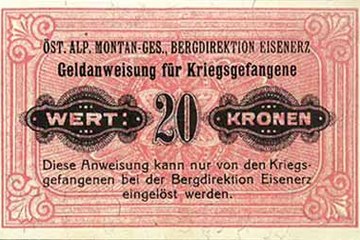The Meaning of Prisoners’ Labour
Actually, according to the Hague Convention on War of 1907, captive military personnel were not supposed to carry out any activities which had a direct connection with war efforts. In fact, however, many enemy soldiers controlled by the opposing troops were even employed near the front. Generally the question arose for some countries as to whether the ‘foreign military persons’ had not become indispensable from an economic viewpoint.
With the continuation of the unexpectedly long fighting, a lack of labour was noticeable everywhere, which led to prisoners of war increasingly being drawn upon from 1915 onwards. Around the year-turn of 1916/17 some 70 to 80 percent of enemy soldiers are estimated to have been working in the German and Russian economies. Comparable developments can be assumed for the Danube Monarchy as well, given that already in autumn of 1915 no more than 30 to 40 percent on average of enemy combatants were to be found in Austro-Hungarian camps.
The experience of life behind barbed wire was thus in no sense typical for the broader masses of prisoners, rather for officers, who usually were not drawn upon for labour deployment due to the laws on war in effect. However, the international laws in force were adhered to only to a limited extent. For instance, early in 1917 there were almost 300,000 enemy soldiers working in battle for the Austro-Hungarian army, though prohibited. Similar figures exist for the Hohenzollern army, while in operational areas of the Russian army – at least for certain offensives – even more prisoners of war could have been.
In some regions and branches, prisoners’ labour took on special significance. In the Urals and in the Donets Basin, for example, they made up 20 to 30 percent of the total economic performance of the region concerned. In all of Russia soldiers of the Central Powers represented 60 percent of iron ore miners, 30 percent of all workers in iron foundries and 28 percent of all peat-cutters. Above all in agriculture, the share of prisoners of war was significant, too. Two-fifths of all Central Powers’ soldiers held on the territory of the collapsing Tsarist Empire were employed in the agrarian sector. Around the turn of 1917/18, there were around 860,000 and 438,000 prisoners in the Hohenzollern Empire and in the Habsburg Monarchy respectively, most of them from the Russian Empire.
The repatriation or exchange of prisoners of war following the armistice with the Soviet government on March 3, 1918 was thus seen as a risk for the German and Austro-Hungarian elites in particular. Germany could not expect even 200,000 of its soldiers back home, yet had to give back more than a million ‘Russians’. ‘That would have to lead to the collapse of our entire economic life’, was the judgement of the Prussian generals. Although Austria-Hungary could receive back a larger ‘labour reservoir’ in this context than it had lost, yet one remained cautious in the Habsburg army, too. On the territory of the former Romanov Empire there were fears of difficulties with evacuation and transport, especially with the background of revolutionary events. The so-called ‘great exchange’ was seen as a heavy economic burden for the Danube Monarchy from this perspective, too.
Leidinger, Hannes/Moritz, Verena: Kriegsgefangenschaft und Kriegswirtschaft, in: Dornik, Wolfram/Gießauf, Johannes/Iber, Walter M. (Hrsg.): Krieg und Wirtschaft. Von der Antike bis ins 21. Jahrhundert, Innsbruck/Wien/Bozen 2010, 461-470
-
Chapters
- Numbers and Dimensions
- Captivity
- The situation of prisoners of war in Austria-Hungary
- Humanitarian catastrophes in captivity
- Aid for prisoners for war
- National propaganda and prisoners of war
- The relationship between prisoners of war and the civilian population
- The Meaning of Prisoners’ Labour
- Witnesses and actors in the revolution
- ‘Transport Home from Captivity’
- Difficult Homecoming












